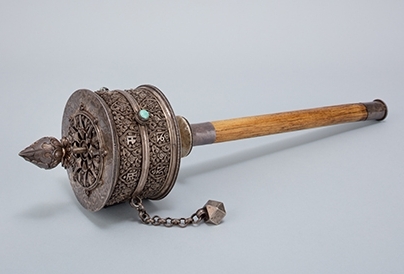
Stupas came to symbolize the Buddha’s enlightened body and mind. Prayer wheels, ritual implements containing mantras that are believed to be released as the wheel turns, are also associated with relics. The cylinder that houses the mantras is called the relics depository because mantras are considered a sacred material that powers the wheel.
The relationship between bodily relics and sacred mantras hinges on the notion of the Buddha’s incorporeal relics—his word, teachings, scriptures, and the truth they contain—known as Dharma relics. In Tibetan Buddhist traditions, mantras are believed to be part of the teachings of the Buddha, and by extension they are also considered sacred Dharma relics. Tibetan Buddhist images of deities are usually consecrated with mantras written on the reverse of the paintings or inserted into sculptures.
See this handheld prayer wheel and learn more in the Tibetan Buddhist Shrine Room and the installation Charged with Buddha’s Blessings: Relics from an Ancient Stupa in the exhibition Gateway to Himalayan Art.
Image Credit
Installation Photography by David De Armas
19.625” h. x 5” w. x 4.5” d.
SC2012.7.2
- https://dev.rubinmuseum.org/images/content/6323/sc2012.7.2__zoom.jpg
- https://dev.rubinmuseum.org/images/content/6323/sc2012.7.2__zoom.jpg

